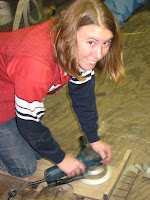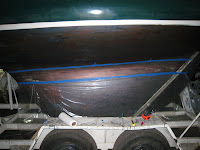Had an hour or so this morning with nothing going on, so I decided to poke around the box of hardware I pulled off the boat. Tackled a couple of the really tiny projects that I would probably usually save until last minute.
Headknocker: For those that haven't sailed on Shields, they have a couple unique rigging bits. One of my favorites is the mainsheet adjustment. Unlike nearly every other racing boat out there, the Shields mainsheet cleat hangs off the boom, on the aptly nicknamed headknocker. Adjustment is made direct from the boom, sometimes with 2 or 3 people pulling from the rail. Also, most headknocker setups use this Nash trigger cleat, which allows you to ease the line by pulling straight back on the clear. This opens the jaws, and lets you do small adjustments kind of like a ratchet.
 Ours was ok, but the Nash cleat was jammed , and I'm not so crazy about the sheave. Like most things, the cleats respond well to being taken apart and cleaned. I happened to have a spare spring, which was good, as one of ours was strangely missing. Also odd was the lack of an eyestrap on the cleat, but luckily I had one as well. The sheave is a plain bearing plastic sheave, which I'll replace with a ball bearing sheave as soon as I find one that fits. I had one that went on 150, but for the life of me can't recall where it came from.
Ours was ok, but the Nash cleat was jammed , and I'm not so crazy about the sheave. Like most things, the cleats respond well to being taken apart and cleaned. I happened to have a spare spring, which was good, as one of ours was strangely missing. Also odd was the lack of an eyestrap on the cleat, but luckily I had one as well. The sheave is a plain bearing plastic sheave, which I'll replace with a ball bearing sheave as soon as I find one that fits. I had one that went on 150, but for the life of me can't recall where it came from.Cunningham: You know it's really a slow day when someone makes a post about the cunningham! There's actually a couple details here that are indicative of how I want to rig this boat. The original blocks were ok, the line was disgusting and there was a wire pennant going to the hook. While I'd like to put some nice tiny carbos on here, I don't want to fix what isn't broken.
 Details: top pennant is 1/8" New England Endura 12. Plenty strong, if I carried smaller I'd use that. Although they're heavy I decided to reuse the hook on the top for sail changing convenience. The control line is just a small length of Swiftcord from my line tails box. The line's been reeved with the blocks at right angles. For any 4:1 or higher purchase using side by side blocks I find this works great; avoids tangles and friction from the lines crossing. I didn't splice this line as it's totally unneccesary for the loads involved, and a proper splice would bulk up the line. The most interesting thing is the soft shackle on the bottom. I'll use these wherever possible on this boat. This lets the block articulate like a swivel shackle, but is less weight and definitely higher on cool factor. Here's another shot of the type of soft shackle I like to make:
Details: top pennant is 1/8" New England Endura 12. Plenty strong, if I carried smaller I'd use that. Although they're heavy I decided to reuse the hook on the top for sail changing convenience. The control line is just a small length of Swiftcord from my line tails box. The line's been reeved with the blocks at right angles. For any 4:1 or higher purchase using side by side blocks I find this works great; avoids tangles and friction from the lines crossing. I didn't splice this line as it's totally unneccesary for the loads involved, and a proper splice would bulk up the line. The most interesting thing is the soft shackle on the bottom. I'll use these wherever possible on this boat. This lets the block articulate like a swivel shackle, but is less weight and definitely higher on cool factor. Here's another shot of the type of soft shackle I like to make:
These are made with an unstitched bury splice at one end, and a stitched knot at
I also pulled the sheave boxes from the main and jib halyards. Class rules and the mast dictate that you use these Schaefer boxes with a combination wire/rope groove. This boat had one very new sheave, and one that was very worn and probably original. The old wire/rope halyards really do a number on sheaves, and I wasn't sure if I could clean up the groove enough to use a new tapered halyad. After a good bit of sanding the surface was nice and smooth and ready for reinstallation.

I wanted these perfect, as a sheave worn by wire will absolutely slaughter a tapered halyard if not prepped right. One of the common customer service issues I have is with people changing their wire/rope halyards to fiber. Before I make the halyard I always ask about the sheave condition and point out that it probably needs sanding at the least. Lots of people listen and check/fix the sheaves. More often though, they say "oh its fine" without having any idea what its actually like, it just doesn't seem that important to them. Sometimes they're right, and theres no problem, sometimes they call me back hoping I'll replace the ripped-up halyard for free. I've seen some truly nasty looking sheaves, usually after someone wants to know why their halyards look like they've been attached by sharks.
Anyway, thats a pretty weak update, so I'll post this prospective paint scheme. My graphic skills suck, but Bill at www.knockaboutsloops.blogspot.com loaned me his line drawing for testing paint colors, and even returned the lines to one design configuration, thanks Bill!

I really like gray boats, and haven't seen a Shields done that way yet. This probably won't happen until next fall, due to money/time/temperature concerns. The topsides and deck don't look great, but I'd rather put time and money into speed and strength, and I can live with an ugly boat. For a season anyway.
























